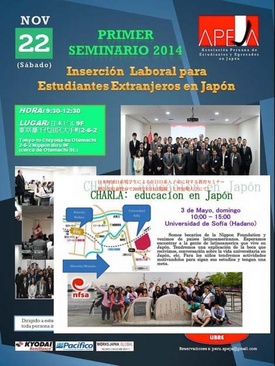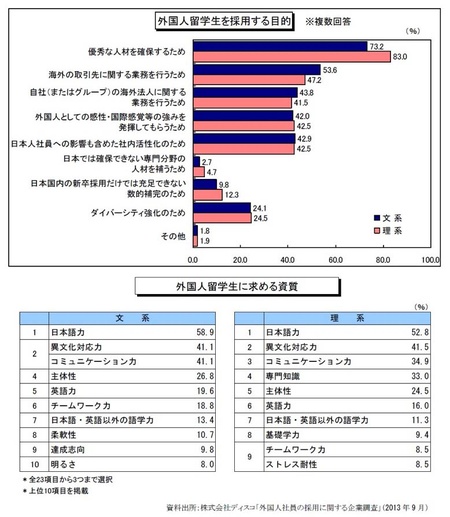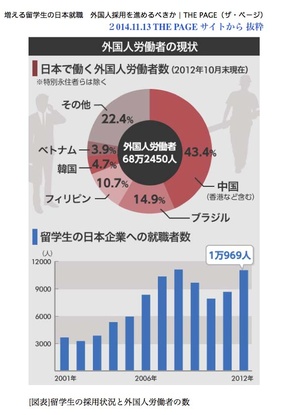As of 2014, the number of international students coming to Japan has increased by 80% compared to 10 years ago. At the time, students from Asian countries still accounted for over 90% of the total, but the number of students from China has increased dramatically during this period1.
According to statistics from 2014, there were 44,970 international students enrolled in Japanese language institutions (80% were from China, Vietnam, and Nepal), and 139,185 were enrolled in universities and graduate schools (also just under 80% were from China, Korea, Vietnam, and Nepal), totaling 184,155.2 Japan's Immigration Bureau has begun to give international students a certain grace period (transitional visa) to change their residence status (visa) after graduation, allowing them to remain in Japan to look for work and make plans for long-term stays.3 Companies and employment support companies are also actively working to employ international students, and universities are collaborating with them to provide information.4
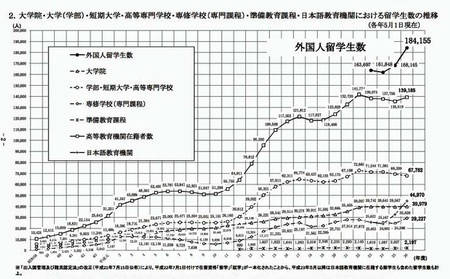
(2014 Survey Results on the Enrollment Status of International Students, p. 4, JASSO, Japan Student Services Organization)
Although South American students make up less than 1% of the total, many of them are government-sponsored students (supported by the Japanese Ministry of Education, Culture, Sports, Science and Technology) and are enrolled in prestigious graduate schools. Even those who are not of Japanese descent have a high level of Japanese language proficiency, and many of them hope to find employment in Japan. Opportunities to share these experiences with juniors and fellow Koreans in Japan are increasing, and in recent years, horizontal connections between international students are also expanding.5
Last November, the APEJA Association of Peruvian Students and Alumni in Japan organized a "Job Hunting Seminar in Japan" in Tokyo. The Peruvian Consul General in Tokyo, university officials, and companies that support international students participated, and I gave a speech as one of the panelists about the current labor market and the type of personnel that companies are looking for.6 The Nippon Foundation's Japanese students group also occasionally holds similar seminars for children of Japanese descendants in South America in Japan.
As a recent trend, large manufacturing companies are prioritizing the hiring of university and graduate school graduates, mainly in the science field. Trading companies and service industries are looking for sales personnel, and evaluate language skills, vitality (hunger spirit), cultural diversity, experience in Japan, cultural characteristics and business practices of the home country, personal connections, etc. Currently, not only large companies but also small and medium-sized enterprises are aiming to expand overseas (mainly due to the shrinking domestic market due to the declining birthrate and aging population), and general university graduates are not able to compete. Of course, just because someone is an international student does not necessarily mean that they meet the conditions required by companies, and it is not so easy to secure suitable human resources. Both companies and universities shout about "global human resources," but the reality is that many of them only understand the surface, and even existing domestic human resources are not being properly utilized.
Currently, Japanese university students are in a seller's market, but they tend not to like the troublesome and risky task of working overseas, so companies are turning their attention to foreign students. However, foreign students also have various expectations and hopes, and Japanese companies are not always able to secure the talent they are looking for in a timely manner. There are several surveys on companies' willingness to hire, 7 and the conditions that companies are looking for include language skills, expertise, local connections and coordination skills in the local area (location of the company). However, the criteria for how to utilize and evaluate such talent (assignment and promotion) are not at all clear. As a result, talented people try to find work at foreign companies where such criteria are clearly defined, or in more attractive countries (not necessarily developed countries, but emerging countries or sometimes thrilling developing countries).
The Ministry of Health, Labor and Welfare has created a "Practical Manual for Utilizing Highly Skilled Foreign Talent" for companies, 8 but the manual basically only emphasizes the convenience of the companies, and the lack of a clear vision for how to evaluate "global talent" may be a negative point for Japanese companies. International students are also very interested in finding work in Japan, but often do not make a mid- to long-term life plan for it. Many choose to use their know-how in their home country or a third country after gaining a few years of experience.
The Immigration Bureau of the Ministry of Justice publishes a report every year on the employment status of international students in Japan. According to statistics for 2013 , 91% of the 12,793 applications for changes in status of residence were approved (68.4% were for Specialist in Humanities/International Services visas, and 20.8% were for technical visas). Of the 11,647 approved applications, 95% were from Asian countries, with 65.6% from China, 10.5% from South Korea, 3.6% from Vietnam, 3.1% from Taiwan, and 2.5% from Nepal. In recent years, the number of Vietnamese and Nepalese students enrolled has increased dramatically (doubling from 2013 to 2014), and their employment rates in Japan are also on the rise.
By occupation, 22.6% were employed in manufacturing, 23.4% in commerce, 9.1% in computer-related, 8.9% in education, 4.8% in food and beverage, 3.7% in electrical equipment, and 3.5% in machinery-related. In terms of company size, 970 students were employed by companies with over 1,000 employees in the manufacturing industry, but many international students also signed contracts with small and medium-sized companies. While many students find employment in the electrical equipment and machinery industries, there are a notable number of cases of students finding employment in companies with 50 or 100 employees or less in the food and beverage, computer-related, civil engineering and construction, travel, and restaurant industries.
In terms of job content, 23.8% were translators/interpreters, 23.6% were sales/sales, 8.1% were information processing, 7.3% were teaching, 5.2% were overseas business, and 4.7% were technology development. By compensation, 33.7% had a monthly salary of 200,000 yen or less, 47.4% had a monthly salary of less than 250,000 yen, 9.7% had a monthly salary of less than 300,000 yen, and 3.3% had a monthly salary of less than 350,000 yen. These monthly salaries are not particularly high overall, and are quite low even in industries with serious labor shortages (some point out that the principle of supply and demand is not working very well). Of the 11,000 people who were allowed to change their visa status, 41.2% were university graduates, 3,165 had master's degrees, 867 had doctorates, and 34.6% had graduate school degrees.10 In addition, the percentage of people who are allowed to change their visa status after graduating from a vocational school is 20.5%, and has been increasing in recent years. By location of the employers, 46% are in Tokyo, 9.3% in Osaka, 6.5% in Kanagawa, 5.3% in Aichi, and 3.8% in Saitama, with over 70% concentrated in the Kanto region.
Companies cite insufficient Japanese language skills among international students and a lack of understanding of Japan's working environment and compensation system as reasons why wages are not so high despite their fairly high final educational level. They also point out issues arising from differences in culture and values, such as the inability to immediately contribute and the difficulty of building teamwork. However, another problem is that many companies are unable to fully utilize the qualities that international students have that Japanese students do not. Many experts have pointed out the lack of ability of Japanese companies to effectively manage foreign human resources both at home and abroad for at least 30 years, and the situation has not improved much even now.
Of course, there are cases where such challenges have been overcome and success has been achieved, but most of these are localized companies, regardless of size, that are actively delegating authority, expanding treatment and promotion systems or equalizing conditions with headquarters employees, participating in profit distribution (acquiring stock certificates, etc.), and promoting employees to executive positions. These companies take the stance of making full use of the abilities and experience of foreigners, regardless of whether they are Japanese or local hires, whether they are university graduates or mid-career hires, and regardless of nationality, while growing together and sharing lessons learned from failures. Japanese companies still place importance on hiring new graduates, but if they want to aggressively expand their business as a global company, they must acquire the ability to properly manage various personnel affairs, including local employees.
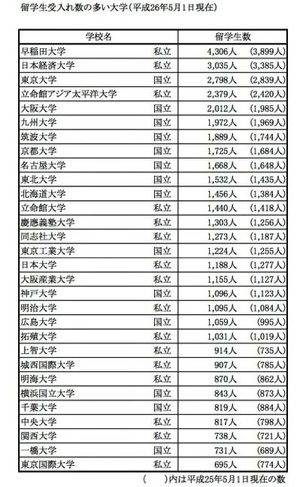
In recent years, the number of international students coming to Japan has been increasing. Not all of them will become highly skilled global talent, but creating a working environment in which they can demonstrate their characteristics and cultural differences is the first step towards developing global talent. In fact, with the increase in foreign tourists, more flexible and pragmatic responses are required across the commerce, travel and service sectors. Employment of international students in these fields may increase in the future.
On the other hand, companies expanding overseas must change their mindset to procure human resources with various skills, nationalities, and races from anywhere in the world, not just Japan. Currently, there are nearly 4 million international students studying somewhere in the world11 , of which 730,000 are in the United States, 410,000 in the United Kingdom, 350,000 in Australia, 260,000 in France, 230,000 in China, and 180,000 in Japan. Contrary to this increasing trend, the number of Japanese students studying abroad is decreasing, currently standing at around 60,000, and fewer than 20,000 in the United States12 .
Regarding global human resources, I will leave it to the articles I have written so far , 13 but looking at the various situations so far, it seems that international students are not aware of how seriously Japanese companies, government, research institutes and universities are actually seeking international students. It may be a kind of fad, just like the "internationalization" phenomenon 20 years ago, but it is certain that in the future, many industries and occupations will need human resources with different ways of thinking and who can compete with the world. The experience of studying abroad not only gives you the opportunity to learn many things, but also a great challenge for the international students themselves, and is the best chance to look at your own country and society from the outside. As a former international student, I have fundamentally examined my previous perspectives and values here in Japan, and this has become a source of growth for me.
Notes:
1. In 2004, Chinese students made up 66.3% of the total, or 77,713 people, and Vietnamese students made up 1,570 (1.3%). However, by 2014, the number of Vietnamese students had increased to 26,439 (11,174 in universities and graduate schools, and 15,265 in Japanese language schools), making them the second largest group of international students, accounting for 14.4% of the total.
- Status of international students enrolled in 2004
- " Studying and training in Japan for Japanese-Americans: its significance and how it can be used to plan for the future " (Discover Nikkei, February 2008)
2. Japanese language education institutions are private Japanese language schools certified by the Ministry of Justice where students can study Japanese in order to enter university or for short-term study abroad.
- Japanese people studying abroad
In recent years, interest in Japanese culture and Cool Japan has led to an increase in short-term study abroad programs, half of which are from Asia, with 10.3% from the United States, 4.2% from France, 3.9% from Germany, and 2.4% from the United Kingdom. Students hoping to enter university study hard for the entrance exams. For undergraduate studies, many students are admitted to private universities (81%), while for graduate studies, the enrollment rate is high at national and public universities (65%).
3. If you are unable to get a job offer before graduation, you can apply to the Immigration Bureau to obtain a "Designated Activities Visa" to continue your job search, which allows you to look for work, including working up to 28 hours a week. The period is six months, but if you receive a recommendation from the university and have reasonable grounds, you can extend it by six months, so international students can look for work after graduation for up to one year (previously, they had to return to their home country once they graduated).
4. JASSO (Japan Student Services Organization)
Japan Career , a job search site
NPO International Students Association (IFSA)
NPA , a job-hunting support group for international students
JAPAN STUDY SUPPORT (Jointly operated by the Asian Students Cultural Association and Benesse)
5. For some time now, Japanese scholarship recipients from the Nippon Foundation have been giving lectures to Japanese descendants in Japan on the importance of orientation and higher education. The Argentinean students CEGAJA and the Peruvian students APEJA also proactively invite foreign students in Japan on other programs and Japanese descendants to attend their job orientation meetings. This kind of exchange not only stimulates each other, but also has the effect of raising self-awareness through the differences in their situations and environments.
6. On November 22, 2014, the event was held in a conference room at WORKS JAPAN, a job-hunting support company, where the experiences of the company's staff and foreign employees were introduced. The event was organized by a Peruvian student studying abroad, but several Peruvian parents and children living in Japan attended.
7. Deisco Co., Ltd. "Corporate Survey on Hiring of Foreign Employees (2013) "
Ministry of Health, Labor and Welfare, Labor Market Analysis Report No. 28, February 2014, "Results of a survey on employment intentions of international students"
CLAIR - Council of Local Authorities for International Relations, "Foreign Students Studying in Japan," 2012
8. Ministry of Health, Labour and Welfare, " Practical Manual for Utilizing Highly Skilled Foreign Human Resources "
9. Ministry of Justice, Immigration Bureau, " Employment status of international students at Japanese companies in 2013 "
10. According to the 2014 Survey on the Enrollment Status of International Students by the Japan Student Services Organization (JASSO), of the 180,000 international students, approximately 40,000 are graduate students, of which 66% are enrolled in national or public universities and 34% in private universities. Of the undergraduate students, 81% are private universities and 19% are national or public universities. Of the approximately 30,000 students enrolled in vocational schools and 45,000 students enrolled in Japanese language institutions, all are private schools.
11. In 1990, there were 1.3 million foreign students with 41,000 in Japan, in 2000 there were 2.1 million with 64,000 in Japan, and in 2014 there were about 4 million foreign students with 180,000 in Japan.
12. Of the 60,000 people, 21,126 are from China, 19,568 from the United States, 3,633 from the UK, 3,097 from Taiwan, 1,955 from Germany, and 1,855 from Australia. ( Based on 2012 statistics )
13. "What is Japan's Global Talent?" Part 1 , Part 2 (Discover Nikkei, December 2013, February 2014)
© 2015 Alberto J. Matsumoto


